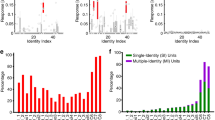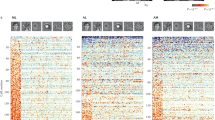Abstract
In this paper, we show that a new set of visual features, derived from a feed-forward model of the primate visual object recognition pathway proposed by Riesenhuber and Poggio (R&P Model) (Nature Neurosci. 2(11):1019–1025, 1999) is capable of matching the performance of some of the best current representations for face identification and facial expression recognition. Previous work has shown that the Riesenhuber and Poggio Model features can achieve a high level of performance on object recognition tasks (Serre, T., et al. in IEEE Comput. Vis. Pattern Recognit. 2:994–1000, 2005). Here we modify the R&P model in order to create a new set of features useful for face identification and expression recognition. Results from tests on the FERET, ORL and AR datasets show that these features are capable of matching and sometimes outperforming other top visual features such as local binary patterns (Ahonen, T., et al. in 8th European Conference on Computer Vision, pp. 469–481, 2004) and histogram of gradient features (Dalal, N., Triggs, B. in International Conference on Computer Vision & Pattern Recognition, pp. 886–893, 2005). Having a model based on shared lower level features, and face and object recognition specific higher level features, is consistent with findings from electrophysiology and functional magnetic resonance imaging experiments. Thus, our model begins to address the complete recognition problem in a biologically plausible way.
Similar content being viewed by others
References
Ahonen, T., Hadid, A., & Pietikainen, M. (2004). Face recognition with local binary patterns. In 8th European conference on computer vision (pp. 469–481).
Bar-Hillel, A., Hertz, T., Shental, N., & Weinshall, D. (2005). Learning a mahalanobis metric from equivalence constraints. Journal of Machine Learning Research, 6, 937–965.
Bieschi, S., & Wolf, L. (2005). A unified system for object detection, texture recognition and cotext analysis based on the standard model feature set. In Proceedings of the British machine vision conference.
Bolme, D. S., Beveridge, J. R., Teixeira, M., & Draper, B. A. (2003). The CSU face identification evaluation system: its purpose, features and structure. In Conference on vision systems (pp. 304–311).
Dalal, N., & Triggs, B. (2005). Histograms of oriented gradients for human detection. In Conference on computer vision and pattern recognition (pp. 886–893).
Etemad, K., & Chellappa, R. (1997). Discriminant analysis for recognition of human face images. Journal of Optical Society of America, 14, 1724–1733.
Fei-Fei, L., Fergus, R., & Perona, P. (2004). Learning generative visual models from few training examples: an incremental Bayesian approach tested on 101 object categories. In CVPR, workshop on generative-model based vision.
Fergus, R., Perona, P., & Zisserman, A. (2003). Object class recognition by unsupervised scale-invariant learning. In Conference on computer vision and pattern recognition (Vol. 2, pp. 264–271).
Fukushima, K. (1980). Neocognitron: a self organizing neural network model for a mechanism for pattern recognition unaffected by shift in position. Biological Cybernetics, 36(4), 193–202.
Goldberger, J., Roweis, S., Hinton, G., & Salakhutdinov, R. (2004). Neighbourhood component analysis. Neural Information Processing Systems, 17, 513–520.
Hastie, T., & Tibshirani, R. (1996). Discriminant adaptive nearest neighbor classification. IEEE Transactions on Pattern Analysis and Machine Intelligence, 18(6), 607–616.
Jones, M., & Viola, P. (2003). Face recognition using boosted local features. In Proceedings of international conference on computer vision.
Kanwisher, N., McDermott, J., & Chun, M. M. (1997). The fusiform face area: a module in human extrastriate cortex specialized for face perception. Journal of Neuroscience, 17(11), 4302–4311.
Lowe, D. G. (2003). Distinctive image features from scale-invariant keypoints. International Journal of Computer Vision, 60(2), 91–110.
Martinez, A. M., & Benavente, R. (1998). The AR face database. CVC Technical Report #24.
Moghaddam, B., Nastar, C., & Pentland, A. (1996). A Bayesian similarity measure for direct image matching. In Conference on computer vision and pattern recognition (p. 638).
Mutch, J., & Lowe, D. (2006). Multiclass object recognition using sparse, localized features. In Conference on computer vision and pattern recognition (pp. 11–18).
Ojala, T., Pietikainen, M., & Harwood, D. (1996). A comparative study of texture measures with classification based on feature distributions. Pattern Recognition, 29, 51–59.
Olshausen, B. A., & Field, D. J. (1997). Sparse coding with an overcomplete basis set: a strategy employed by V1? Vision Research, 37, 3311–3325.
Phillips, P. J., Moon, H., Rizvi, S. A., & Rauss, P. J. (2002). The FERET evaluation methodology for face recognition algorithms. Pattern Analysis and Machine Intelligence, 22(10), 1090–1104.
Pontil, M., & Verri, A. (1998). Support vector machines for 3D object recognition. IEEE Transactions on Pattern Analysis and Machine Intelligence, 20(6), 637–646.
Riesenhuber, M., & Poggio, T. (1999). Hierarchical models of object recognition in cortex. Nature Neuroscience, 2(11), 1019–1025.
Samaria, F., & Harter, A. (1994). Parameterisation of a stochastic model for human face identification. In 2nd IEEE workshop on applications of computer vision.
Schölkopf, B., & Smola, A. J. (2002). Learning with kernels. Cambridge: MIT.
Serre, T., Wolf, L., & Poggio, T. (2005). Object recognition with features inspired by visual cortex. In Conference on computer vision and pattern recognition (Vol. 2, pp. 994–1000).
Shan, C., Gong, S., & McOwan, P. (2005). Conditional mutualinformation based boosting for facial expression recognition. In Proceedings of the British machine vision conference.
Turk, M., & Pentlanbd, A. (1991). Eigenfaces for recognition. Journal of Cognitive Neuroscience, 3, 71–86.
Ungerleider, L. G., & Mishkin, M. (1982) Two cortical visual systems. In: Analysis of visual behavior, (pp. 549–586). Cambridge: MIT.
Wang, H., Li, S., & Wang, Y. (2004). Face recognition under varying lighting conditions using self quotient image. In IEEE international conference on automatic face and gesture recognition (pp. 819–824).
Weber, M., Welling, M., & Perona, P. (2000). Unsupervised learning of models for recognition. In European conference on computer vision (pp. 19–32).
Zigmond, M. J. (1999). Fundamental neuroscience (1st ed.). New York: Academic Press.
Author information
Authors and Affiliations
Corresponding author
Rights and permissions
About this article
Cite this article
Meyers, E., Wolf, L. Using Biologically Inspired Features for Face Processing. Int J Comput Vis 76, 93–104 (2008). https://doi.org/10.1007/s11263-007-0058-8
Received:
Accepted:
Published:
Issue Date:
DOI: https://doi.org/10.1007/s11263-007-0058-8




